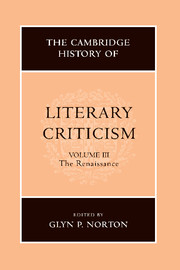Book contents
- Frontmatter
- Introduction
- READING AND INTERPRETATION: AN EMERGING DISCOURSE OF POETICS
- POETICS
- I Humanist classifications
- II The rediscovery and transmission of materials
- III Rhetorical poetics
- IV Literary forms
- 20 Italian epic theory
- 21 The lyric
- 22 Renaissance theatre and the theory of tragedy
- 23 Elizabethan theatrical genres and literary theory
- 24 Defining comedy in the seventeenth century: moral sense and theatrical sensibility
- 25 Dialogue and discussion in the Renaissance
- 26 The essay as criticism
- 27 The genres of epigram and emblem
- 28 Humour and satire in the Renaissance
- THEORIES OF PROSE FICTION
- CONTEXTS OF CRITICISM: METROPOLITAN CULTURE AND SOCIO-LITERARY ENVIRONMENTS
- VOICES OF DISSENT
- STRUCTURES OF THOUGHT
- NEOCLASSICAL ISSUES: BEAUTY, JUDGEMENT, PERSUASION, POLEMICS
- A SURVEY OF NATIONAL DEVELOPMENTS
- Bibliography
- Index
- References
21 - The lyric
from IV - Literary forms
Published online by Cambridge University Press: 28 March 2008
- Frontmatter
- Introduction
- READING AND INTERPRETATION: AN EMERGING DISCOURSE OF POETICS
- POETICS
- I Humanist classifications
- II The rediscovery and transmission of materials
- III Rhetorical poetics
- IV Literary forms
- 20 Italian epic theory
- 21 The lyric
- 22 Renaissance theatre and the theory of tragedy
- 23 Elizabethan theatrical genres and literary theory
- 24 Defining comedy in the seventeenth century: moral sense and theatrical sensibility
- 25 Dialogue and discussion in the Renaissance
- 26 The essay as criticism
- 27 The genres of epigram and emblem
- 28 Humour and satire in the Renaissance
- THEORIES OF PROSE FICTION
- CONTEXTS OF CRITICISM: METROPOLITAN CULTURE AND SOCIO-LITERARY ENVIRONMENTS
- VOICES OF DISSENT
- STRUCTURES OF THOUGHT
- NEOCLASSICAL ISSUES: BEAUTY, JUDGEMENT, PERSUASION, POLEMICS
- A SURVEY OF NATIONAL DEVELOPMENTS
- Bibliography
- Index
- References
Summary
Within the loose system of literary genres that existed in the passage from the Middle Ages to the Renaissance, lyric has an especially problematic trajectory. For one thing, lyric is always – even today – the most fugitive of genres when it comes to a theory of its identity. And for another, the period in question is probably the starting point of the modern idea of lyric productions as short, intense, and exquisite redactions of impassioned speech – a notion that is much further developed in the Romantic period, but has recognizable beginnings in the early Renaissance. One consequence of this latter view is that lyric theory comes to seem almost a contradiction in terms: where it is assumed that speech can be idealized into poetry and poetry naturalized into speech, a poetics of lyric like those of epic or drama can seem beside the point. Moreover, the disparity between the available terms of lyric theory and the actual productions of the genre becomes arrestingly evident in this period. In many ways the most acute poetics of the early modern lyric is written out in poems themselves, such as Garcilaso de la Vega's Egloga tercera (written c. 1526, published 1543) and Edmund Spenser's Shepheardes calender (1579), where poets and their audiences often find the common ground for genre orientated conversation they otherwise lack. Hence the emergence of lyric in this period – its separation from the other genres, its theory and practice – must be sought in many untoward places, and witnessed alongside other events.
- Type
- Chapter
- Information
- The Cambridge History of Literary Criticism , pp. 216 - 228Publisher: Cambridge University PressPrint publication year: 1999
References
- 4
- Cited by



